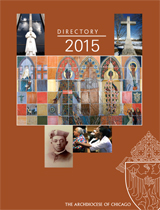March 30, 2008
Of myths and monsters
The Field Museum has a new exhibit, kind of a rarity for a natural history museum; it’s an exhibit about creatures that exist only in people’s minds.
“Mythic Creatures: Dragons, Unicorns and Mermaids” opened in March and runs through Sept. 1.
After I got a press release from the museum looking for coverage, I decided to take Caroline on a day off from school.
We got a personalized tour of the exhibit, which was created by the American Museum of National History in New York, in cooperation with several other museums, including the Field.
Walking under the 120-foot Chinese parade dragon, through the models of mermaids and unicorns, and stopping at a small area devoted to the “chupacabra,” a mythical creature that’s been around only a few decades, project curator Tom Skwerski didn’t seem too sure how these creatures relate to a life of faith.
Then we came faceto- face with a 16th century statue of St. George, he of dragonslaying fame. And Skwerski noted that while the unicorn often symbolized Christ in medieval art, the only one of the creatures mentioned in the Bible is the dragon in Revelations, the one seeking to devour the Queen of Heaven’s newborn baby and sweeping stars from the sky with its tail.
The display also includes some books used centuries ago in Catholic universities, with taxonomies of creatures now considered mythical, or — in J.K. Rowling’s world, magical. (Dragons, mermaids and unicorns — along with giants, kappas and phoenixes — all make appearances at Hogwarts).
What struck me, and Caroline, was that people all over the world imagined the same general sorts of creatures over and over again, but they imagined them differently. Dragons in Asia are powerfully good; they bring rain. In Europe, the dragon has always been a force of destruction.
People might look at these creatures as an attempt to explain what was then inexplicable, much the way non-believers look at faith today.
But the exhibit offers a slightly different take, showing how fossils of, say, a dinosaur that had a beak like a bird and four legs, could have led people to think it came from a griffin, a mythical creature with the front of an eagle and hindquarters of a lion.
It’s not a stretch, Skwerski said, to think that people could have put those fossils together and come up with a griffin.
In that way, they could have been acting like modern-day scientists, just with fewer resources to draw on.
But the creatures have survived, in popular imagination at least, and that’s why the museum is interested in them — for their cultural, not scientific significance.
Judging from the world Caroline and her generation inhabit, the mythical creatures won’t be disappearing anytime soon. They show up in children’s books — from picture books up, and not just in Harry Potter — and in Japanese anime. We are a creative people, made in the image and likeness of a creative God, so why should it come as a surprise that we come up with creatures that nature never made to symbolize our hopes and fears?
Martin is assistant editor of the Catholic New World. Contact her at [email protected].
 Catholic
New World - Newspaper for the Archdiocese of Chicago
Catholic
New World - Newspaper for the Archdiocese of Chicago Archdiocese of Chicago Directory
Archdiocese of Chicago Directory Oficjalne wydawnictwo Archidiecezji Chicago w języku polskim
Oficjalne wydawnictwo Archidiecezji Chicago w języku polskim
